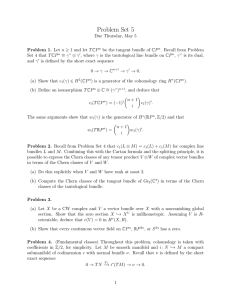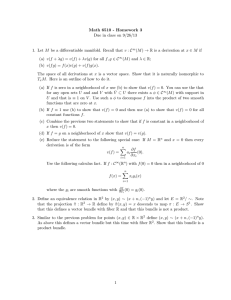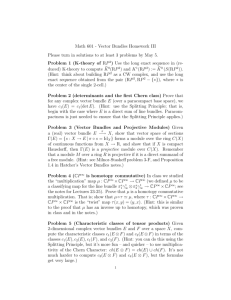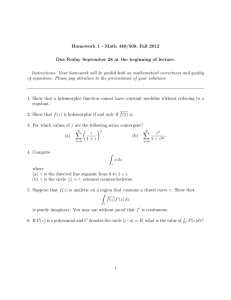SOME EXERCISES IN CHARACTERISTIC CLASSES 1. G G -B
advertisement
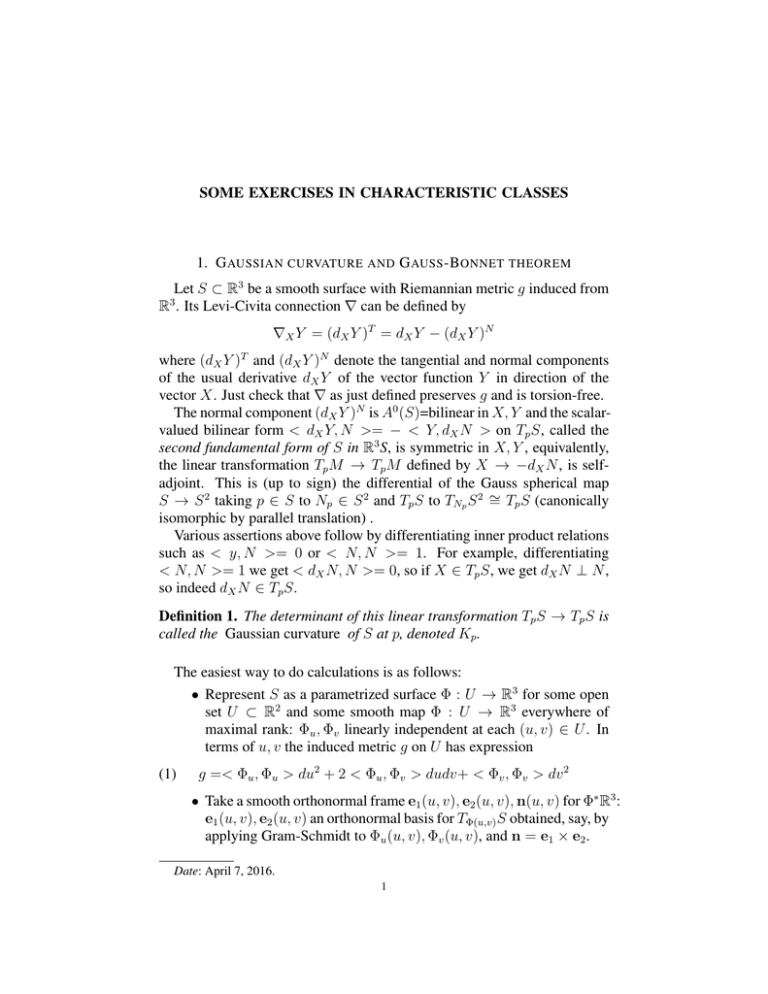
SOME EXERCISES IN CHARACTERISTIC CLASSES
1. G AUSSIAN CURVATURE AND G AUSS -B ONNET THEOREM
Let S ⊂ R3 be a smooth surface with Riemannian metric g induced from
R . Its Levi-Civita connection ∇ can be defined by
3
∇X Y = (dX Y )T = dX Y − (dX Y )N
where (dX Y )T and (dX Y )N denote the tangential and normal components
of the usual derivative dX Y of the vector function Y in direction of the
vector X. Just check that ∇ as just defined preserves g and is torsion-free.
The normal component (dX Y )N is A0 (S)=bilinear in X, Y and the scalarvalued bilinear form < dX Y, N >= − < Y, dX N > on Tp S, called the
second fundamental form of S in R3 S, is symmetric in X, Y , equivalently,
the linear transformation Tp M → Tp M defined by X → −dX N , is selfadjoint. This is (up to sign) the differential of the Gauss spherical map
S → S 2 taking p ∈ S to Np ∈ S 2 and Tp S to TNp S 2 ∼
= Tp S (canonically
isomorphic by parallel translation) .
Various assertions above follow by differentiating inner product relations
such as < y, N >= 0 or < N, N >= 1. For example, differentiating
< N, N >= 1 we get < dX N, N >= 0, so if X ∈ Tp S, we get dX N ⊥ N ,
so indeed dX N ∈ Tp S.
Definition 1. The determinant of this linear transformation Tp S → Tp S is
called the Gaussian curvature of S at p, denoted Kp .
The easiest way to do calculations is as follows:
• Represent S as a parametrized surface Φ : U → R3 for some open
set U ⊂ R2 and some smooth map Φ : U → R3 everywhere of
maximal rank: Φu , Φv linearly independent at each (u, v) ∈ U . In
terms of u, v the induced metric g on U has expression
(1)
g =< Φu , Φu > du2 + 2 < Φu , Φv > dudv+ < Φv , Φv > dv 2
• Take a smooth orthonormal frame e1 (u, v), e2 (u, v), n(u, v) for Φ∗ R3 :
e1 (u, v), e2 (u, v) an orthonormal basis for TΦ(u,v) S obtained, say, by
applying Gram-Schmidt to Φu (u, v), Φv (u, v), and n = e1 × e2 .
Date: April 7, 2016.
1
2
SOME EXERCISES IN CHARACTERISTIC CLASSES
• Since de1 is perpendicular to both e2 and n (differentiate < e1 , e2 >=
0 and D< e1 , n >= 0), using from the above paragraphs that the
e2 -component of de1 = ∇e1 , and finally the definition of connection one-forms θij from the notes on connections, we get the first
equation below. Similar reasoning for the second:
de1 = θ12 e2 + λ1 n
de2 = θ21 e1 + λ2 n
dn = −λ1 e1 − λ2 e2
(2)
for suitable one-forms θ12 , θ21 = −θ12 , λ1 , λ2 ∈ A1 (U ).
The third equation is obtained from the first two by first using <
dei , n >= λi , i = 1, 2, and then using < dei , n >= − < ei , dn >.
A consequence of the third equation is the following formula for the
Gaussian curvature (as defined above, extrinsically):
K dA = λ1 ∧ λ2
(3)
(4)
where dA is the (oriented) area element of the metric g on U :
p
dA = det(g) du dv
where g is as in (1).Since the determinant meaures the distortion in
area, we see that (??) is equivalent to Definition 1. This is the extrinsic of curvature, meaning that it Uses the shape of the embedding of
S in R3 .
1.1. The Exercises.
(1) Compute d2 e1 by using (2), then set the resulting expression = 0
(since d2 = 0). Show that this gives Gauss’s Theorema Egreguium
(5)
K dA = −dθ12 (= dθ21 ),
where the left-hand side is defined as in Definition 1, or, equivalently, equation (3), is an extrinsic quantitity (defined in terms of
the shape of the embedding in R3 ), while the right-hand side is an
intrinsic quantity (depends just on the Levi-Civita connection of the
induced metric, hence just on the induced metric.)
Remark Recall, from the notes on connections, that d2∇ s = Ωs
for some Ω ∈ A2 (S, Sk(T )), where Sk(T ) ⊂ End(T ) denotes
the bundle of skew-symmetric endomorphisms of T , and where we
have changed the K = K∇ of the notes to Ω because now we reserve K for the Gaussian curvature (a function on S). On a metric
SOME EXERCISES IN CHARACTERISTIC CLASSES
3
connection on a bundle of rank 2 , Ω is represented by a matrix of
2-forms
0 dθ21
0 Ω12
with Ω12 = −Ω21 .
=
Ω=
dθ12 0
Ω21 0
From the intrinsic point of view, (5) says K dA = Ω12 = P f (Ω).
(2) Let Φ(u, v) = (sin u cos v, sin u, sin v, cos u), 0 ≤ u ≤ π, 0 ≤ v ≤
2π be the standard parametrization of the unit sphere centered at the
origin by spherical coordinates (where the circles u = 0, u = π collapse to the north pole, south pole respectively), Make the following
choices for e1 , e2 , n:
(6)
e1 = φu = (cos u cos v, cos u sin v, − sin u),
e2 = Φv / cos u = (− sin v, cos v, 0),
n = Φ.
Work out explicitly all the equations (1) to (5) for these particular
choices of Φ, e1 , e2 , n. In particular, what is the value of K?
(3) Suppose now that S is an oriented surface with a Riemannian metric
g (not neccessarily induced from an embedding in R3 ) and associated Levi-Civita connection ∇. We have seen two ways of looking
at the curvature d2∇ ;
(a) d2∇ s = Ωs for some Ω ∈ A2 (S, Sk(T )) as above and in the
notes..
(b) d2∇ s = ιs R for some R ∈ A2 (S, Λ2 T ) ⊂ ⊕p,q S p (S, Λq T ) as in
class. We have, for x ∈ T , a contraction operator ιx : Λp T →
∼
=
Λp−1 T and in particular an isomorphism Λ2 T −→ Sk(T ) that
takes x ∧ y ∈ Λ2 T to the skew-symmetric endomorphism z →
ιz (x ∧ y) =< x, z > y− < y, z > x for x, y, z ∈ T . This
isomorphism takes R to Ω.
Let u ∈ A0 (S, Λ2 T ) be the unique section that is of unit length
and is positive for the chosen orientation. Over any open set
with positively oriented orthonormal frame e1 , e2 , u = e1 ∧ e2 .
Note that the Pfaffian P f (R) ∈ A2 (S) is obtained from R ∈
A2 (S, Λ2 T ) by
P f (R) =< u, R >
The Exercise:
4
SOME EXERCISES IN CHARACTERISTIC CLASSES
(i) Let σ ∈ A0 (S, T ) be a vector field of constant length:
< σ, σ >= 1. Prove that
d∇ (σ ∧ d∇ σ) = R
consequently
(7)
(8)
d < u, σ ∧ d∇ σ >= P f (R)
(ii) Now suppose S = S̄ \ {p1 , . . . , pn } where S̄ is a closed
surface and {p1 , . . . , pn } is the set of zeros of a vector
field on S̄ having only simple zeros. Apply Stokes’s theorem and (7) to σ = s/|s| to get
Z
n
X
P f (R) =
ιpi (s) = χ(S)
S̄
i=1
(4) Apply the procedure of the last problem to the example of spherical
coordinates (Exercise (2) above). Check that equations (7) and (8)
for σ one of the fields e1 or e2 .
SOME EXERCISES IN CHARACTERISTIC CLASSES
5
2. A DDITIONAL E XERCISES
(1) (Milnor-Stasheff 4B): Prove the following theorem of Stiefel: If
n + 1 = m2r with m odd, then RP n does not have 2r vector fields
that are linearly independent at every point. In particular, show that
RP 4k+1 has a nowhere zero vector field but does not have 2 vector
fields that are linearly independent at every point.
(2) (Milnor-Stasheff 5E): A vector bundle E → B is said to be of finite type if and only if B can be covered by finitely many open sets
U1 , . . . , Uk such that E|Ui is trivial for i = 1, . . . , k. Prove that
the tautological line bundle L → RP ∞ is not of finite type. This
is the bundle denoted by γ 1 in Milnor-Stasheff. (Note that a bundle over a reasonable space of finite covering dimension (such as
a finite-dimensional manifold) is necessarily of finite type. So to
find an example not of finite type the base space B must be infinitedimensional.)
(3) (Milnor-Stasheff 15B): Let Gn (R∞ ), respectively G˜n (R∞ ) denote
the Grassmannian of unoriented, respectively oriented n-dimensional
subspaces of R∞ . Observe that G˜n (R∞ ) is a two - sheeted covering space of Gn (R∞ ). Let Λ be an integral domain in which 2 is
invertible. For instatnce, could take Λ = Q. Recall that we have
computed H ∗ (G˜n (R∞ ), Λ).
Exercise: Prove that H ∗ (Gn (R∞ ), Λ) is the polynomial ring over
Λ generated by the Pontrjagin classes p1 (γ n ), . . . , p[n/2] (γ n ) of the
universal (= tautological) Rn -bundle γ n over Gn (R∞ ).
Suggestion Prove first the following general statement: For any
double covering π : X̃ → X with covering transformation t : X̃ →
X̃ of order two, π ∗ : H ∗ (X, Λ) → H ∗ (X̃, Λ) is injective and its
image is the fixed point set of the involution t∗ : H ∗ (X̃, Λ) →
H ∗ (X̃, Λ).
(4) Let L → M and E → M be a complex line bundle and a complex
vector bundle of rank n (that is, fiber Cn ) respectively.
(a) Compute the total Chern class c(L ⊗ E) in terms of the Chern
classes of L and E. (Suggestion: Use the splitting principle).
(b) Same for c(Hom(L, E)).
(c) Suppose the base M has real dimension 2n, and let L, E be as
above. Give a necessary and sufficient condition, in terms of
6
SOME EXERCISES IN CHARACTERISTIC CLASSES
the Chern classes of L and E, for the existence of an injective
bundle homomorphism φ : L → E.
(5) A quick look at complex hypersurfaces in Pn+1 :
Let h ∈ H 2 (Pn+1 , Z) ∼
= Z be the generator with the property
that h([P1 ]) = 1, where P1 ⊂ Pn+1 is the natural holomorphic
embedding (actually linear). This is called the positive generator
of H 2 . The complex line bundles over Pn+1 often denoted O(d),
d ∈ Z, notation chosen so that c1 (O(d)) = dh. Thus for d < 0,
O(d) has no holomorphic sections other than the identically zero
section, and O(0) is the trivial bundle with its holomorphic sections
constant functions on Pn+1 .
Now, if d > o, the space of holomorphic sections of O(d) is in bijective correspondence with the space P (n + 2, d) of homogeneous
polynomials of degree d in n + 2 variables. If f ∈ P (n + 2, d),
the equation f = 0 defines a subset (analytic subvariety) of Pn+1 ,
the zero set of a holomorphic section of O(d). If the only common
zero of the equations fxi = 0 (partial derivaatives with respect to all
n + 2 variables) is at the origin, then f = 0 defines a non-singular
hypersuface, let’s call it Xd . It is a complex manifold of complex
dimension n. All non-singular f give diffeomorphic Xd , under diffeomorphisms that preserve the Chern classes.
Fix n and d, let X = Xd and let ιX : X → Pn+1 be the embedding. The normal bundle of X in Pn+1 is easily seen to be ι∗X (O(d))
(from the fact that X is the zero set of a section of O(d) transverse
to the zero section). So the standard decomposition (C ∞ but not
holomorphic)
T X ⊕ N X = ι∗X T Pn+1
(9)
becomes
(10)
T X ⊕ ι∗X O(d) = ι∗X T Pn+1
If we let u = ι∗X h ∈ H 2 (X, Z) (where h ∈ H 2 (Pn+1 , Z) is the
positive generator as above), then (10) allows us to compute c(X)
as follows:
(11)
c(X) =
(1 + u)n+2
1 + du
(a) Warm-up exercise Use (11) to compute:
(i) c1 (X) for any n and d in terms of u.
SOME EXERCISES IN CHARACTERISTIC CLASSES
7
(ii) Argue that
(12)
un ([X]) = d
by interpreting (by Poincaré duality) cup products as intersection products, and using that un = ι∗X hn and hn is
Poincaré dual to a line (P1 ) in Pn+1 .
(iii) Use the two previous problems to derive formulas for the
Euler characteristic χ(Xd ) = cn (Xd ) for n = 1, 2, 3.
(b) Now to Milnor-Stasheff 16- D. First we need to simplify the
definition of the Chern class sk (E). For a line bundle, define
sk (L) = c1 (L)k ∈ H 2k (X). Extend to all bundles by requiring
that it be additive and natural. This means: If E = L1 ⊕ · · · ⊕
Lm , sk (E) = c1 (L1 )k +· · ·+c1 (Lm )k , and extend to all bundles
by the splitting principle. (In terms of symmetic functions, the
sk (t1 , . . . , tn ) are the power sums sk (t1 , . . . , tn ) = tk1 + · · · +
tkn are, for fixed n and k ≤ n, an alternative set of algebra
generators for the algebra of symmetric functions in t1 , . . . , tn ,
related to the elementary symmetric functions by the famous
Newton formulas.)
Observe that sk (E ⊕ F ) = sk (E) + sk (F ).
Exercise Prove that sn (Xd ) = d(n + 2 − dn ).
(6) (Milnor-Stasheff 16-E, F) This exercise gives more constructions of
complex n-dimensional manifolds X with sn (X) 6= 0 and of real ndimensional manifolds Y with the analogous Stiefel-Whhitney class
sn (Y ) 6= 0. Such a Y is not cobordant to a sum of products of lower
dimensional manifolds
(a) Hypersurfaces in products of complex projective spaces:
The holomorphic line bundles in products Pm × Pn of two projective spaces are the bundles O(d1 , d2 ) = π1∗ O(d1 )⊗π2∗ O(d2 ),
where π1 , π2 are the projections onto the two factors.
Assume 2 ≤ m ≤ n and let Xm,n ⊂ Pm × Pn be the zero set of
a holomorphic section s of O(1, 1) which is transeverse to the
zero section. Equivalently, Xm,n is the zero set in Pm × Pn of
a polynomial f (x, y), for (x, y) ∈ Cm+1 × Cn+1 that is of bidegree (1, 1): of degree one in x and in y, that is, f (sx, ty) =
stf (x, y) for all s, t ∈ C, and so that the common solutions of
fxi = 0, fyj = 0 are contained in 0 × Cn+1 ∪ Cm+1 × 0, for
8
SOME EXERCISES IN CHARACTERISTIC CLASSES
example
(13)
f (x, y) = x0 y0 + x1 y1 + · · · + xm ym
Then Xm,n is a complex hypersurface in Pm × Pn , therefore a
complex manifold of complex dimension m + n − 1.
Exercise Prove that
(14)
sm+n−1 (Xm,n ) = −
(m + n)!
m!n!
Suggestion Use the same reasoning in this situation as the one
used in (9) and (10) to derive formulas for the characteristic
classes of Xm,n . In particular, show that, since T (Pm × Pn ) =
π1∗ T Pm ⊕ π2∗ T Pn of bundles of rank less than n, its sm+n−1 class vanishes, so sm+n−1 (Xm,n ) = −smn −1 (O(1, 1)). Then
compute its Chern class from O(1, 1) = π1∗ O(1) ⊗ π2∗ O(1).
(b) Hypersurfaces in products of real projective spaces:
The procedure just studied for complex manifolds and Chern
classes can be repeated for real manifolds and Stiefel-Whitney
classes. For instance, the class sk (E) can be defined, using the
splitting principle, as the class determined by sk (L) = w1 (L)k
when L is a real line bundle.
Let’s just look at one example, which is particularly interesting in that it gives the smallest example of an oriented odddimensional manifold that is not a boundary. Let Y ⊂ RP 2 ×
RP 4 be a non-singular hypersurfce of bi-degree (1, 1): take
f (x, y) = 0 with f as in (13) with m = 2, n = 4.
Exercise
(i) Prove that Y is orientable. (Suggestion: compute w1 (Y ))
(ii) Prove that s5 (Y ) 6= 0. (Suggestion: derive and use the
analogue of (14)).
(7) Show that the odd - dimensional complex projective spaces CP 2m+1
bound by producing an explicit orientable manifold X of real dimension 4m + 3 with boundary CP 2m+1
Suggestion: CP 2m+1 is the space of complex one-dimensional linear subspaces of C2m+2 . Let H denote the quaternions, let HP m
denote the space of one-dimensional right quaternionic linear subspaces of Hm+1 . Identify C2m+2 with Hm+1 . Show that every complex line is contained in a unique right-quaternionic line, and that
SOME EXERCISES IN CHARACTERISTIC CLASSES
9
this leads to a fibration
S 2 → CP 2m+1 → HP m
Then find a real vector bundle E with fiber R3 whose sphere bundle
is the above S 2 -bundle.
